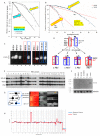The RB1 Story: Characterization and Cloning of the First Tumor Suppressor Gene
- PMID: 31683923
- PMCID: PMC6895859
- DOI: 10.3390/genes10110879
The RB1 Story: Characterization and Cloning of the First Tumor Suppressor Gene
Abstract
The RB1 gene is the first described human tumor suppressor gene and plays an integral role in the development of retinoblastoma, a pediatric malignancy of the eye. Since its discovery, the stepwise characterization and cloning of RB1 have laid the foundation for numerous advances in the understanding of tumor suppressor genes, retinoblastoma tumorigenesis, and inheritance. Knowledge of RB1 led to a paradigm shift in the field of cancer genetics, including widespread acceptance of the concept of tumor suppressor genes, and has provided crucial diagnostic and prognostic information through genetic testing for patients affected by retinoblastoma. This article reviews the long history of RB1 gene research, characterization, and cloning, and also discusses recent advances in retinoblastoma genetics that have grown out of this foundational work.
Keywords: cancer genetics; gene cloning; genetic testing; retinoblastoma; tumor suppressor gene.
Conflict of interest statement
TPD is on the scientific advisory board of ProQR and has provided consultations to Merck and Iveric; those activities are intellectually unrelated to the topic of this paper. JLB has filed a provisional patent application titled, Aqueous Humor Cell-Free DNA for Diagnostic and Prognostic Evaluation of Ophthalmic Disease. The other authors declare no conflicts of interest.
Figures

Similar articles
-
Novel insights into RB1 mutation.Cancer Lett. 2022 Oct 28;547:215870. doi: 10.1016/j.canlet.2022.215870. Epub 2022 Aug 12. Cancer Lett. 2022. PMID: 35964818 Review.
-
[Promoting regulated gene diagnosis for retinoblastoma in clinical work].Zhonghua Yan Ke Za Zhi. 2019 Nov 11;55(11):806-810. doi: 10.3760/cma.j.issn.0412-4081.2019.11.003. Zhonghua Yan Ke Za Zhi. 2019. PMID: 31715676 Review. Chinese.
-
Pan-cancer molecular analysis of the RB tumor suppressor pathway.Commun Biol. 2020 Apr 2;3(1):158. doi: 10.1038/s42003-020-0873-9. Commun Biol. 2020. PMID: 32242058 Free PMC article.
-
Comprehensive characterization of RB1 mutant and MYCN amplified retinoblastoma cell lines.Exp Cell Res. 2019 Feb 15;375(2):92-99. doi: 10.1016/j.yexcr.2018.12.018. Epub 2018 Dec 22. Exp Cell Res. 2019. PMID: 30584916
-
Characterization of human-induced pluripotent stem cells carrying homozygous RB1 gene deletion.Genes Cells. 2020 Jul;25(7):510-517. doi: 10.1111/gtc.12771. Epub 2020 Apr 28. Genes Cells. 2020. PMID: 32277725
Cited by
-
The significance of RB1 in multiple myeloma.Front Immunol. 2024 Nov 27;15:1415972. doi: 10.3389/fimmu.2024.1415972. eCollection 2024. Front Immunol. 2024. PMID: 39664374 Free PMC article. Review.
-
Normal and Neoplastic Growth Suppression by the Extended Myc Network.Cells. 2022 Feb 21;11(4):747. doi: 10.3390/cells11040747. Cells. 2022. PMID: 35203395 Free PMC article. Review.
-
Mutation spectrum of retinoblastoma patients in Vietnam.Mol Genet Genomic Med. 2023 Nov;11(11):e2244. doi: 10.1002/mgg3.2244. Epub 2023 Aug 7. Mol Genet Genomic Med. 2023. PMID: 37548407 Free PMC article.
-
Ocular manifestations in pediatric tumor suppressor gene mutations: a case series and literature review of RB1, NF1, NF2, VHL, and TSC.BMC Pediatr. 2025 May 10;25(1):371. doi: 10.1186/s12887-025-05694-6. BMC Pediatr. 2025. PMID: 40346602 Free PMC article. Review.
-
Genetics in ophthalmology: molecular blueprints of retinoblastoma.Hum Genomics. 2023 Sep 1;17(1):82. doi: 10.1186/s40246-023-00529-w. Hum Genomics. 2023. PMID: 37658463 Free PMC article. Review.
References
Publication types
MeSH terms
Substances
Grants and funding
LinkOut - more resources
Full Text Sources
Other Literature Sources
Miscellaneous

